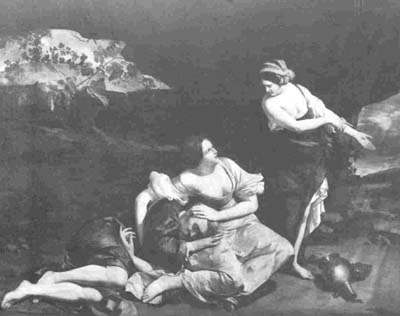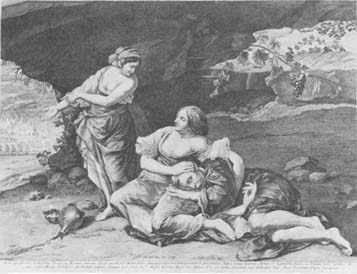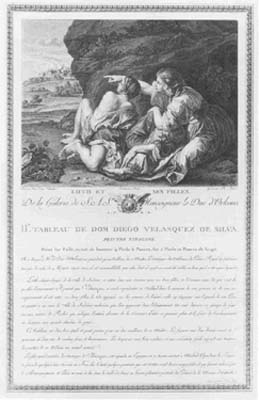
Bulletin 14, 1969
Home
Français
Introduction
History
Annual Index
Author &
Subject
Credits
Contact



Orazio
Gentileschi and the
Theme of "Lot and His Daughters"
by R. Ward Bissell
Pages 1
| 2 | 3
| 4
| 5
| 6
| 7
| 8
An investigation of the
Lot and His Daughters in the National
Gallery of Canada raises one further problem. Before the paintings
in the Orléans collection were dispersed in the late eighteenth
century, engraved versions of them were produced. A drawing by
Borel of the Lot and His Daughters, then attributed to Velasquez,
served as the basis for Philippe Trière's print (fig. 13). (16)
Clearly the engraving, with the broadleafed plant in the corner, the
different rock formation and the burning hilltown, does not
reproduce exactly the known painting. Since there can be no doubt
as to the history of the Ottawa canvas (even the size of the
painting corresponds to the measurements indicated below the
engraving), an explanation of this discrepancy must be sought. It is
doubtful, given the function of the print, that the draftsman or engraver intentionally altered or manufactured details. Rather,
I believe that the engraving was produced after a painting of small
format in order to facilitate copying. One such reduced version on
wood, said to copy the picture in the Orléans collection, appeared
in the Le Brun sale, Paris, in 1791, and may have been purchased by
Pamard of Avignon (Appendix II, 3 and 4). Another panel painting,
twice the size of the Le Brun example but identical in form to the
engraving, is said to have been presented by Pope Clement XIV to the
9th Earl of Exeter in 1774 and still hangs in Burghley House at
Stamford (fig. 10; Appendix I, 3)
That the tiny panel in Paris was an original replica by Gentileschi,
who is known to have worked in small scale, is indeterminable,
though doubtful. The version belonging to the Marquess of Exeter is
of high quality. The polished, less painterly surface results, in
part at least, from the medium employed. Nonetheless, certain
weaknesses challenge its authenticity. The head of the younger
daughter is poorly drawn; the ruddy flesh tones as well as the
blue-green of Lot's coat and the green of the trees in the middle
distance are overly assertive; and while the fantasy-like town is
well painted, for all of its unreasonable demands upon the viewer's
attention, the remainder of the landscape is very schematic. But
whether by a skilled copyist, as I believe it may be, or by Orazio
himself, the picture at Burghley House is probably based upon a now
lost original by Gentileschi. It does not reproduce the Lot and
His
Daughters at Ottawa; to the changes previously noted can be added
the observation that the colours of the older daughter's skirt
(golden yellow) and of her sister's blouse (steel-gray) are not those
of the known example.
Orazio Gentileschi's practice of repeating with variations his own
compositions intensified as his career progressed. So too did his
penchant for rarefied effects, stimulated, no doubt, by the
aristocratic and royal patrons for whom he worked. The Lot and
His
Daughters of about 1628 in the Museo de Bellas Artes at Bilbao,
painted undoubtedly for Charles I of England and engraved by Lucas
Vorstermann, is a case in point (figs. II and 12; Appendices 1,4 and
II, 5 and 6). The accent is now upon courtliness, from the graceful
postures of the slender daughters with their small heads to the
affected gestures. This is Gentileschi' s grand manner, and superb
technical refinement becomes virtually an end in itself. The rocks
behind, with fussy grape vines and ivy hanging from them, are no
longer so closely related to the figures. In reversing the position
of Lot so that the composition might build upward in stages toward
the standing figure, Orazio shifted the dramatic focus. The
observer's eye quickly sweeps past Lot, a movement reinforced by the
tendency to "read" a painting from left to right. (17) As
if to compensate for this disequilibrium, Gentileschi turned back
inward the glance of the standing daughter and parallelled her
outstretched arm to the oblique posture of the other daughter, the
metal jug serving as an intermediate diagonal. And, as if to
compensate for the attenuated force of the total presentation,
Gentileschi introduced such ostensibly titillating details as the
partially exposed breasts of the women and the indelicate position
of the right hand of Lot, who himself is a less wizened type (as the
daughters in turn are more mature). In all, the Lot and His
Daughters at Bilbao lacks the powerful concentration of the earlier
examples. It strangely evokes memories of that mannered elegance against which Caravaggio and
then his followers, Orazio
included, had reacted.
Had Orazio Gentilcschi declined Sauli's invitation, this picture
would never have been painted. His skill as an artist and some
judiciously executed schemes led him from Genoa to Turin (perhaps),
to Paris, and ultimately to the court at London. The Lot and His
Daughters in the National Gallery of Canada was produced precisely
in that period when Gentileschi began to achieve an international
reputation. Yet it is fair to say that the most vital years for his
art were those which he spent on or near Via Margutta in the
artists' quarter of Rome. Exactly how Orazio's art might have
evolved had he remained in Italy is problematic. It is worth
noting, however, that certain of his works at Fabriano seem, in
retrospect, to contain already the essential features of his late
style. Moreover, a comparison of the pensive Lot and His Daughters
of 1628 to, for example, Pietro da Cortona's dramatic Rape of the
Sabines of approximately the same year demonstrates as graphically
as possible both the astounding diversity of Italian baroque
painting and some of the unique gifts of Orazio Gentileschi.
Next Page | Notes
1
| 2 | 3
| 4
| 5
| 6
| 7
| 8
Annual Index | Author & Subject | Credits | Contact
This digital collection
was produced under contract to Canada's Digital Collections program,
Industry Canada.
"Digital
Collections Program, Copyright
© National Gallery of
Canada 2001"